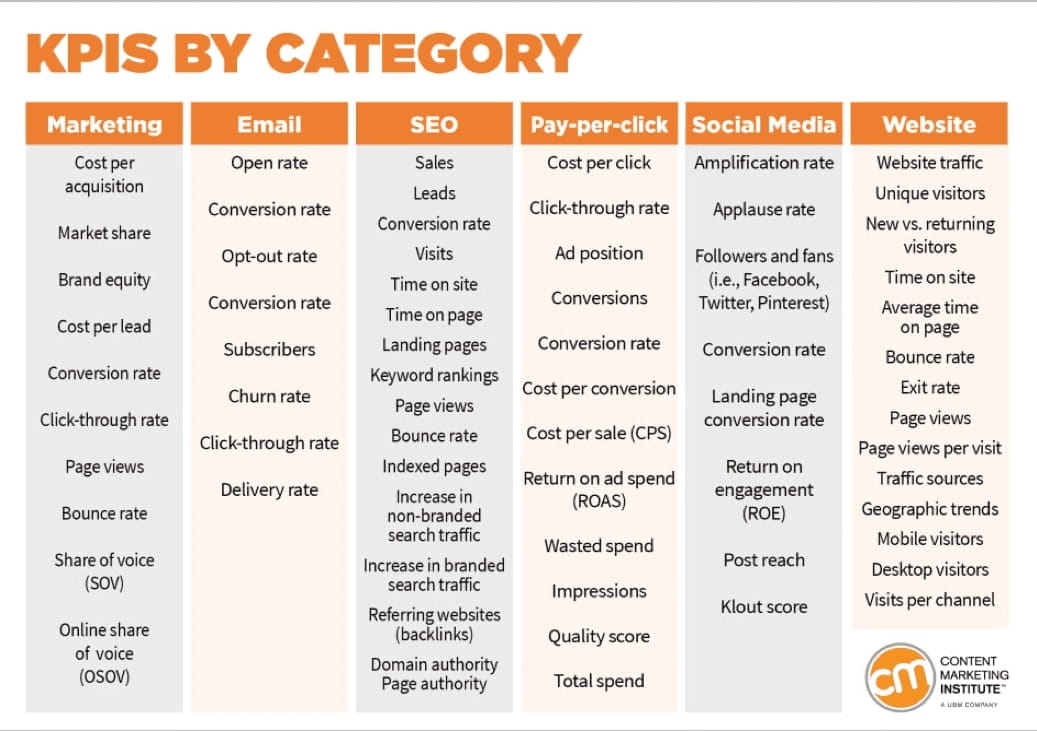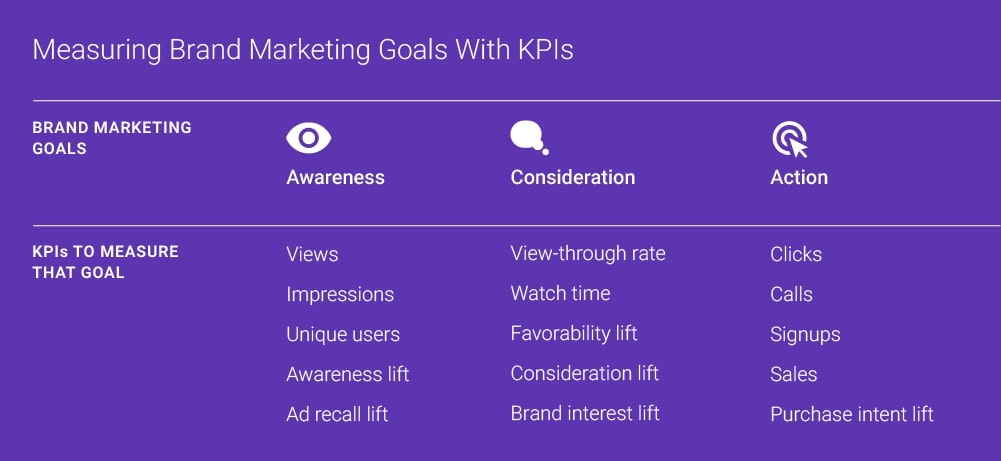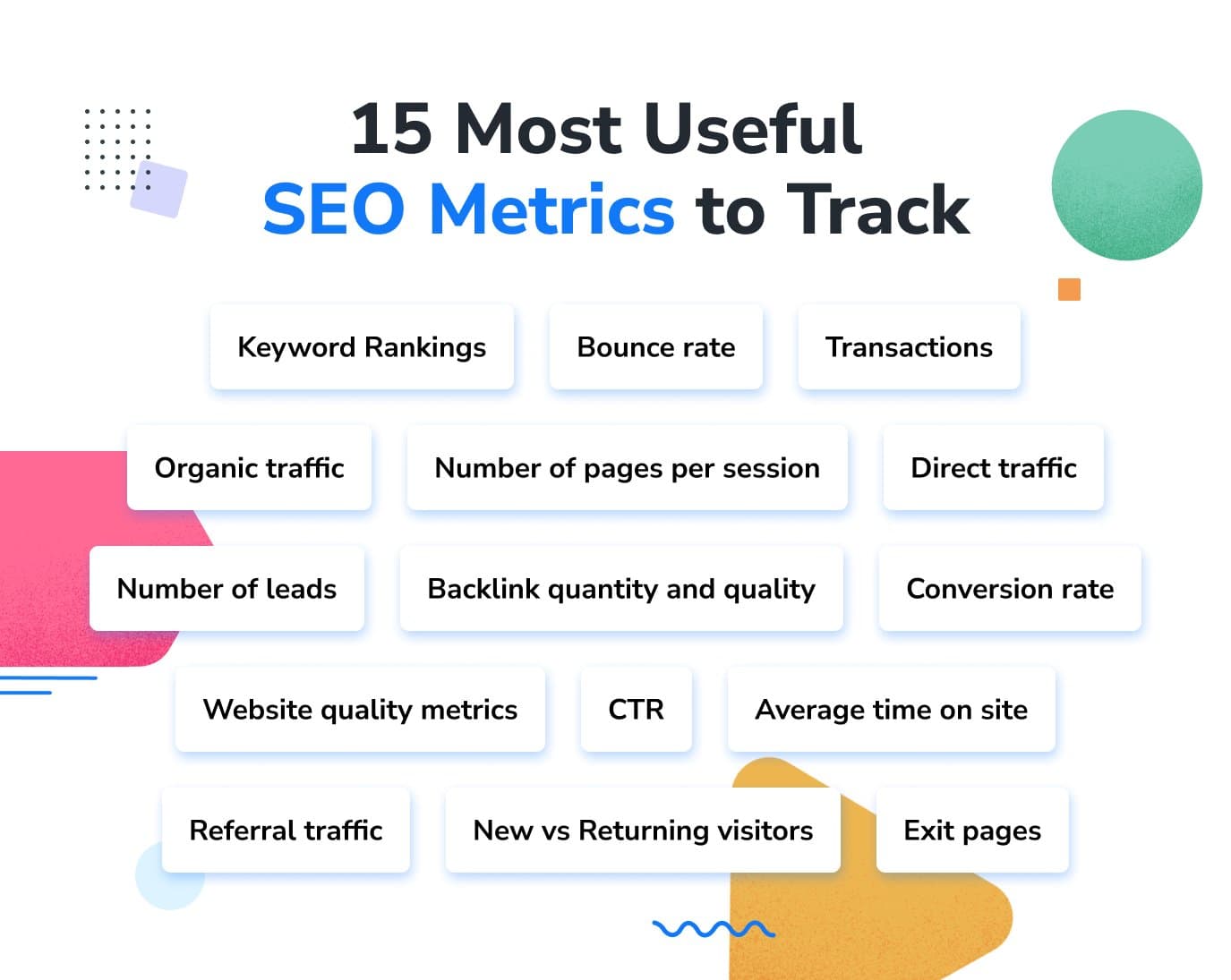You can’t improve what you can’t measure. By choosing the right digital marketing KPIs, you can track if your marketing campaigns move a needle and learn what content needs to be optimized to perform better. Let’s explore the core digital marketing KPIs that can help you accomplish your goals.
What are Digital Marketing KPIs?
Digital marketing KPIs are used to determine the success of your marketing campaigns. They are a measurable value that defines if your marketing objectives have been achieved.
There are a lot of digital marketing KPIs you can track. However, you shouldn’t necessarily track all of them — just those most important for your business.
In this article, we explore the most important KPIs that most businesses track.
Digital Marketing KPI Examples – What are They?
In this article, we review the following KPIs by groups — lead generation, brand awareness, website performance, SEO metrics, and email marketing success metrics.

Table of Contents:
Lead generation
You cannot generate sales without driving leads first. Let’s check what metrics you can use to find out if your lead generation effort pays off.

1. Traffic
Your website traffic is the number of visitors that come to your website every month. You can analyze traffic by various time periods – days, weeks, months, or year to year.
How to measure website traffic?
Google Analytics reports are the best tracking system for website traffic.
How to improve website traffic?
You can increase the number of website visitors by investing more in paid ads, creating more new website content, or optimizing your existing content.
2. Traffic to lead
The traffic to lead metric shows how much traffic converts into leads. The metric helps understand if the traffic you drive to the website is of high quality and converts into sign-ups, free trials, or demo sessions.
Traffic per lead formula
Number of website visitors/ number of leads * 100
How to measure traffic per lead?
Create a dedicated Excel sheet with a traffic per lead formula. There, you can track this KPI by adding new data every month. You can also automate this process by using KPI dashboard tools.
How to improve traffic per lead?
To improve your traffic per lead ratio, choose more targeted keywords and create content with different keyword variations. This will drive more traffic to your site that can benefit from using your products or services. You can also improve mobile friendliness and website speed, and double-check your lead sign-up forms for errors.
3. Cost per lead
This metric shows how much marketing budget you spend on every lead you generate.
Cost per lead (CPL) formula
Total marketing spend / number of leads
How to measure cost per lead?
Use a dedicated Excel sheet with the CPL formula or invest in an automation tool that imports information about lead count and marketing spend from your CRM or other tools you use to store this information.
How to improve cost per lead?
You can reduce acquisition cost by optimizing your marketing expenses and focusing more on lead generation channels that drive high-quality leads at the lowest cost. You can also consider spending less on or killing channels that generate leads at the highest cost.
Brand awareness
With high brand awareness among your core audience, you can sell your products easier and faster. High brand awareness fosters trust among your customers and makes spending money on your products an easy decision.
So what are the metrics that determine if your brand is recognizable? Let’s have a look.

1. Brand recall
Brand recall shows how many people remember and correctly identify your brand after seeing or hearing about it.
Brand recall formula
Number of survey respondents who correctly identified your brand / Number of survey respondents * 100
How to measure brand recall?
Brands usually measure brand awareness through surveys.
How to improve brand recall?
Build an authentic brand to connect with your audience. Learn what is important for your customers and create a narrative that reflects their values. Use video marketing and paid brand awareness campaigns to reach your audience with this message. Monitor the effectiveness of different brand recall activities by sending regular brand recall surveys.
2. Social mentions
There is a correlation between positive social mentions and increased traffic on the website. That’s why it’s worth tracking their impact. You can measure social mentions by calculating how many times people mention your brand on social media every month.
How to measure social mention?
Set up a social listening stream. Various social monitoring tools automate the process of finding mentions about your brand on different social media platforms.
How to increase social mentions?
Various activities make your brand more recognizable and contribute to more social mentions. For example, you can speak at conferences that your target audience attends, create an inspiring video on social media and distribute it, or invest in outdoor campaigns.
3. Net Promoter Score
The net promoter score (NPS) describes how likely customers are to mention your brand to a friend or relative.
How to measure net promoter score?
You can send NPS surveys asking this question, “How likely are you to mention [your brand name] to a friend?” and let customers grade their response on a scale from 1 to 10.
How to improve NPS?
Collect customer feedback by adding an additional open-ended question at each NPS survey. Ask customers what they would like to improve or what they disliked about your products or customer service. Use this feedback to improve operations.
Website performance
To convert traffic into leads and sales at a higher rate, your website should also tick some boxes. Let’s check how you can measure website performance and make improvements to boost leads and sales.
1. Page conversion rate
The goal of a call to action on a website is to lead people to sign up for a free trial, finalize a purchase, or book a call with sales. Page conversion rate helps you identify if your calls to action fulfill their role.
Page conversion rate formula
Number of people who have completed a goal on a website or page/number of website or page users
How to measure page conversion rate?
Use Google Analytics reports to collect information about goal completions and the number of visitors for a given time. You can use automation tools that pull information from different data sources to calculate this metric.
How to improve page conversion rate?
Work on your page copy to make it more actionable. Set up A/B tests (if you drive enough traffic to achieve statistical significance) and experiment with different CTA copy or color, images, or text. Make sure to only test one thing at a time, otherwise, you won’t know what change has increased your conversion rate.
2. Time on site
Time on site shows how much time visitors spend on your website.
How to measure time on site?
It’s best to use Google Analytics reports to track this metric.
How to increase time on site?
Write engaging content that keeps people reading. You can also use internal linking to connect articles with each other, so your readers can easily explore other content on your website.
3. Website speed
Slow websites hurt user experience. People leave a page if it takes more than a few seconds to load. It also negatively impacts your Google rankings – Google downgrades websites that load slowly. You should track your website speed on both web and mobile to make sure it works properly as you introduce further changes.
How to measure time on site?
Use Google PageSpeed Insights to keep track of your website’s speed.
How to speed up your website?
Use Google PageSpeed Insights to identify issues causing slow speed and work to remove them.
SEO Metrics
Organic traffic can become one of the most profitable channels for growth; unlike with paid ads, you create your website content once and it will work for you forever. You can improve its performance if you optimize it over time. So, what metrics should you track to make sure your SEO strategy works and you can achieve your content marketing goals?

1. Inbound links to a website
The number of links leading to your website defines your website’s authority. The more backlinks point at your domain, the better you rank in search results, which drives traffic and generates leads and sales.
How to measure time on site?
Use SEO tracking tools to monitor existing and new inbound links.
How to get more backlinks?
Appear in news, become a contributing writer for respected news outlets, and write publications that get mentions in reports and studies.
2. Organic search traffic
Organic search traffic is the number of visitors coming to your site from Google. You can measure the effectiveness of your SEO strategy by monitoring the change in organic search traffic.
How to track organic search traffic?
Use Google Analytics reports on traffic channels to check how much traffic comes from search engines.
How to grow organic traffic?
Optimize existing content for SEO, do your keyword research and improve the content you already have — add more similar keywords in different variations, use internal linking, and build more backlinks leading to your website. Write new content that includes targeted keywords that have a high traffic volume.
3. Conversions from organic search
Tracking the number of conversions coming from organic search helps understand the profitability of organic content. This metric shows the number of people who convert after finding your content on Google by typing a specific keyword or phrase.
How to track conversions from organic search?
Categorize your customers by acquisition source (organic) and group them by dates (last month).
How to grow conversions from organic traffic?
Make sure your landing pages are optimized to drive user action. They should communicate value propositions well and give an incentive for people to click. Choose your targeted keywords wisely; check their search intent first to understand what people have in mind when typing a keyword in Google. Follow search intent in every content piece you write or optimize.
4. Keywords in the top 10 SERP
When was the last time you went to the second Google results page? That’s right, we don’t usually do that. To get more clicks, your content should appear on the first page. To get more traffic to your website, you have to outrank hundreds of other pages targeting your keyword to turn up in the top SERP. To outrank other pages, you must know how your pages rank now so you can optimize them.
How to track the top 10 SERP?
Use SEO tools that track your SERP position on specific keywords or utilize the capabilities of Google Search Console.
How to improve your SERP position?
Build backlinks leading to the articles containing your target keywords, optimize content to include more similar keywords, and include correct headings and a suggested number of images. There are many other basic SEO recommendations to improve your content rank.
5. Rank increase of target keywords
As you optimize your content and get more outbound links, you can determine what effect these changes bring to your website traffic. Checking the rank increase of your keywords will give you the full picture of the effectiveness of your actions.
How to track rank increase?
Set up notifications for a rank increase on target keywords using third-party tools.
How to improve?
Build more backlinks to the content containing your target keywords, and optimize it according to the best SEO practices.
Email marketing metrics
Email marketing is another channel that drives leads and customers. You should track KPIs for email marketing if you plan to make it a part of your marketing strategy.
1. Open rate
Email open rate is an email marketing metric that shows the percentage of subscribers who open your email. Use this metric to track the effectiveness of your headlines.
Email open rate — formula
total unique opens/total recipients * 100
How to track the open rate?
Check the open rate of every campaign through the reporting options in your email marketing service.
How to improve?
Carry out A/B tests to check what email content performs better. Create test campaigns and send it to a small subscriber group. check which headline variant works the best, and use it to send to the rest of the list.
2. Click through rate
The Click-through rate is the percentage of subscribers who interact with your email links and calls to action. This metric helps understand if your email content drives user action.
Click through rate — formula
Number of clicks/number of emails you have sent * 100
How to track click-through rate?
Check the click-through rate of every campaign through the reporting options in your email marketing service. You can also calculate the rate manually using the above formula.
How to improve the click-through rate?
Write more actionable and engaging email content. Write shorter sentences, include more calls to action, and provide subscribers with more incentives. For example, you can offer a special discount, promo code, or surprise offer to get them to click on your website and check your offer.
3. Conversion rate
The conversion rate shows the percentage of people who have received your email campaign and performed the desired action, such as buying your products or signing up for a trial or demo.
Email conversion rate — formula
Number of people who completed the desired action/number of total emails delivered * 100
How to track email conversion rate
You can use product analytics tools to pull sales data from relevant sources and calculate conversion rates according to the above formula.
How to improve the email conversion rate?
Make your value proposition clear to email subscribers, include better incentives to drive action, and send your emails to the customer segment that is most interested in your product.
Wrapping up
You don’t have to track dozens of different metrics to find out if you are on track with your marketing strategy. Choose the metrics that are important for your business and inform your marketing success. Be consistent in tracking the progress — make it a routine, easy, and effortless process.






